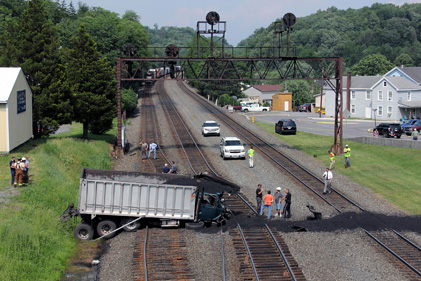At approximately 3 p.m. on June 12, a coal-hauling dump truck lost its brakes while travelling southeast on Jackson Street in Summerhill. Unable to stop or make the turn at the bottom of the hill, the truck traveled through an intersection and through the parking lot of a former car dealership and onto Norfolk Southern’s Pittsburgh Mainline. Main track 3 was the most heavily damaged, but Main 2 was also knocked out of alignment while Main 1 was covered with spilled coal.
NS westbound train 11A was able to stop in time and traffic was stopped and held on all three tracks until the main lines could be repaired.
Croyle Township police said 47-year Dennis Barnes of Johnstown was driving for Samuel D. Brink Trucking Inc. of Ebensburg, Pa. at the time of the crash.
The driver was able to climb from the vehicle and went to Conemaugh Memorial Medical Center for an evaluation.
The tracks reopened for service Saturday.















Two "At least, thank Goodness"es; 1. The driver wasn't trying to beat the train and (2) He wasn't killed. Brake failures happen sometimes.
My dad, who drove for Railway Express Agency from 1940 to 1960, taught me to drive. He said, "Don't go down a hill in a higher gear than you went up it." Of course, this was before automatic transmissions. He took pride in his twenty year safe driving record. He did hit a drunk who walked in front of him, but he was not held responsible for the accident.
Perhaps PTC (Positive Truck Control) could have prevented this runaway…………………..HAHAHA….Congress………????
MR ROBERT BELL, In terms of Trucks on hills, the standard practice is to down shift one gear at the top of the climb or grade. Once the truck is descending the hill allow the speed to build up to the posted safe speed limit and use periodic breaking to slow the truck 5 miles below the limit. Release break and Repeat.
I'll bet that was one harrowing ride for the driver. He won't soon forget it. It was very fortunate that 11A was able to stop in time. That was probably a very tense moment for the train crew also.
Nobody was badly hurt or killed, something to be thankful for.
One lucky driver as far as what this accident could've turned out to be.
No "Jake" brake on the truck, or is their use prohibited by local ordinance (a not uncommon occurrence, across the USA)? Was he legal from a GVW (Gross Vehicle Weight) standpoint?
One might notice parallels between this incident and Phila. last month.
Track one (1) was opened not long after the accident, using it for both eastbound and westbound traffic. Of course, westbound traffic needed to have permission from the dispatcher as track one (1) has no westbound signals. I watched Amtrak #43 go west on #1 around 6 o'clock sandwiched in between a couple of westbound freights.
If the driver was in low-low gear he should not have a problem. In Australia many steep hills have a sign "Trucks MUST use low gear" Maximum 15 Km/hour. Don't they do the same in the USA & Canada?
Brad,
Your comments in the last couple of sentences apply to, but I guess we all know this, mountain grade freight trains, though in freight train runaways, this truck was a "runaway," defective brakes are hardly ever a factor.
Jack and George,
Lucky and harrowing, won't soon forget it"…..there's a high probability that mere "excessive speed, " made the accident inevitable….see Brad's final sentences.
Re Mr. Shaft; I would guess a driver in that area spends all day going up and down hills. It is not common practice to check brakes before every hill one may encounter, although some extreme hills would dictate an actual inspection. It is very rare for the brakes to suddenly become ineffective from the last time they were applied. Speaking in general terms, and certainly not specifically about this incident in that I obviously know no details about it, a case like this is quite often not from the brakes failing, but from the operator failing to begin application at the proper time. A careful driver can control a truck with weak brakes, yet a truck with complete brakes can be lost by a inattentive driver. Again let me stress that I don't know any details of this incident, and I am in no way accusing the driver of any wrong.
The 1914 Sanborn map shows Main Street exactly where it is now and shows there was a bridge even 101 years ago.
This is at the bottom of a very long hill. The photo is taken from the bridge which likely replaced an at-grade crossing near where the truck ended up. The road now requires a 90 degree turn to the right at the bottom of the hill in order to access the road up to the bridge. My father and I were trainwatching at this site last Fall and the coal truck traffic here eventually led us to depart.
Looks like the PRR signals are still in place though. The ones facing toward the camera face westbound and are raised up so the train crews can see them over the bridge deck.
Do the coal truck drivers check their brakes? before starting down hill.